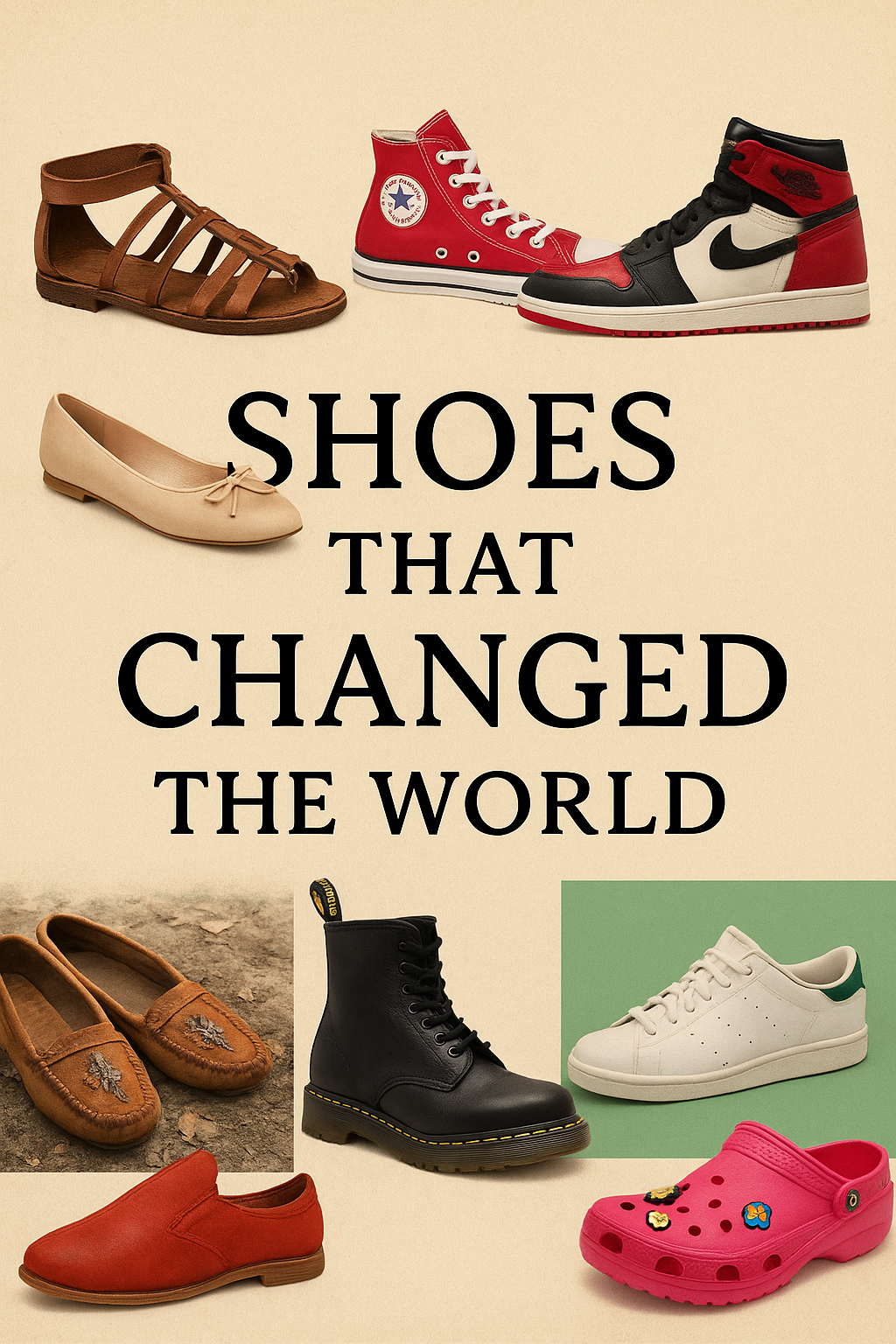Shoes are not just protective gear for our feet — they’re cultural symbols, statements of style, and sometimes even powerful tools of social change. Throughout history, certain shoes have stood out, leaving an unforgettable mark on fashion, sports, politics, and everyday life. From ancient sandals to high-tech sneakers, these iconic shoes tell stories about who we are and where we’ve been.
Below is a friendly guide in tabular format to the shoes that changed the world, followed by FAQs.
📊 Shoes That Changed the World – A Historical Timeline
| Shoe Name | Era/Year | Why It’s Iconic | Impact on History & Culture |
|---|---|---|---|
| Roman Sandals (Caligae) | Ancient Rome (27 BC – 476 AD) | Worn by Roman soldiers for durability and mobility. | Helped expand the Roman Empire by supporting armies during long marches. Symbol of power and discipline. |
| Medieval Poulaines | 14th–15th Century Europe | Pointy shoes that showed wealth and class. | Represented status; the longer the shoe, the richer the wearer. Changed footwear fashion into a status symbol. |
| Moccasins | Indigenous America (Pre-Colonial) | Soft leather shoes crafted by Native Americans. | Practical, eco-friendly design influenced modern loafers & casual shoes. Preserved cultural identity. |
| Wooden Clogs (Sabots) | 16th Century Europe | Worn by peasants and workers for protection. | Symbol of working class; later became a protest icon during industrial revolutions (workers threw them into machines — origin of the word sabotage). |
| Converse Chuck Taylor All Star | 1917 (USA) | The first mass-produced basketball shoe. | Became a cultural icon across music, sports, and fashion. Still popular after 100+ years. |
| Ballet Flats (inspired by Pointe Shoes) | 1940s | Coco Chanel popularized flats for women. | Brought comfort to women’s fashion. Remains timeless in modern wardrobes. |
| Dr. Martens Boots | 1960s (Germany/UK) | Durable boots originally made for workers. | Adopted by punks, rockers, and rebels. Became a global symbol of youth rebellion. |
| Nike Air Jordan 1 | 1985 (USA) | First signature basketball sneaker for Michael Jordan. | Revolutionized sneaker culture, made shoes a collectible, and boosted NBA’s popularity worldwide. |
| Adidas Stan Smith | 1971 (USA) | Iconic white tennis shoe. | Became a universal fashion staple, bridging sportswear and streetwear. |
| Christian Louboutin Red Soles | 1990s (France) | High heels with signature red soles. | Symbol of luxury and power in women’s fashion. Changed the luxury shoe market. |
| Crocs | 2002 (USA) | Lightweight foam clogs for comfort. | Once mocked, now embraced for practicality, healthcare, and casual fashion. |
| Yeezy Sneakers | 2015 (USA) | Designed by Kanye West with Adidas. | Redefined sneaker drops, limited-edition hype culture, and resale market. |
🌍 Why These Shoes Left a Mark in History
Shoes reflect social movements, cultural values, and human progress. For example:
- Roman sandals symbolized empire and conquest.
- Dr. Martens stood for rebellion and subcultures.
- Air Jordans transformed sneakers into a global billion-dollar industry.
- Crocs proved that comfort can beat fashion rules.
In short, shoes are more than footwear — they’re a reflection of history on our feet.
🕰️ Detailed Insights into Iconic Shoes
1. Roman Sandals (Caligae)
The Roman legions wore sturdy leather sandals with iron studs. Without them, long military campaigns would have been impossible. These shoes helped Rome expand across Europe and left an imprint (literally) on roads that still exist today.
2. Poulaines – The “Instagram Flex” of Medieval Times
In the Middle Ages, the rich flaunted their wealth through shoe length. Some were so long they had to be tied to the wearer’s leg! This showed how fashion often equals status and class.
3. Dr. Martens – From Workers to Rockstars
Originally designed as orthopedic work boots, Dr. Martens became a punk rock rebellion symbol. Worn by musicians, workers, and activists, they’re now part of street style worldwide.
4. Nike Air Jordan 1 – The Sneaker That Started It All
When the NBA banned Michael Jordan’s red-and-black sneakers, Nike turned it into a marketing goldmine. The Air Jordan 1 kicked off sneaker culture and showed how shoes could be art, investment, and identity.
5. Crocs – The Comeback of Comfort
Laughed at in the early 2000s, Crocs became popular again due to their practicality, especially in healthcare and casual wear. They remind us that comfort always finds its way back into fashion.
👟 FAQs About Shoes That Changed the World
| Question | Answer |
|---|---|
| Which shoe is considered the most influential sneaker ever? | The Nike Air Jordan 1 is widely seen as the most influential sneaker, sparking sneaker culture and the resale market. |
| What’s the oldest type of shoe in history? | The oldest known shoes are sandals made from plant fiber, dating back to around 7,000 BC. |
| Why are Converse Chuck Taylors still popular? | Their timeless design, versatility, and cultural presence in music, film, and sports keep them relevant. |
| Did wooden clogs really inspire the word sabotage? | Yes! Workers threw clogs (sabots) into machinery during protests, giving rise to the word “sabotage.” |
| Are Crocs now considered fashionable? | Surprisingly, yes. Crocs have collaborated with high-end brands like Balenciaga and are trending in streetwear. |
| What luxury shoe left the biggest mark? | Christian Louboutin’s red-soled heels redefined luxury footwear in the 1990s and remain a status symbol. |
| Which shoes represent rebellion? | Dr. Martens and Converse are both associated with counterculture, music, and youth rebellion. |
🎯 Conclusion
Shoes are far more than just something to walk in — they are history, identity, and innovation wrapped around our feet. From Roman sandals that marched across Europe to Air Jordans that changed sports and fashion forever, shoes have shaped societies, cultures, and even economies.
Next time you lace up, remember: you’re not just wearing shoes — you’re walking in history.



